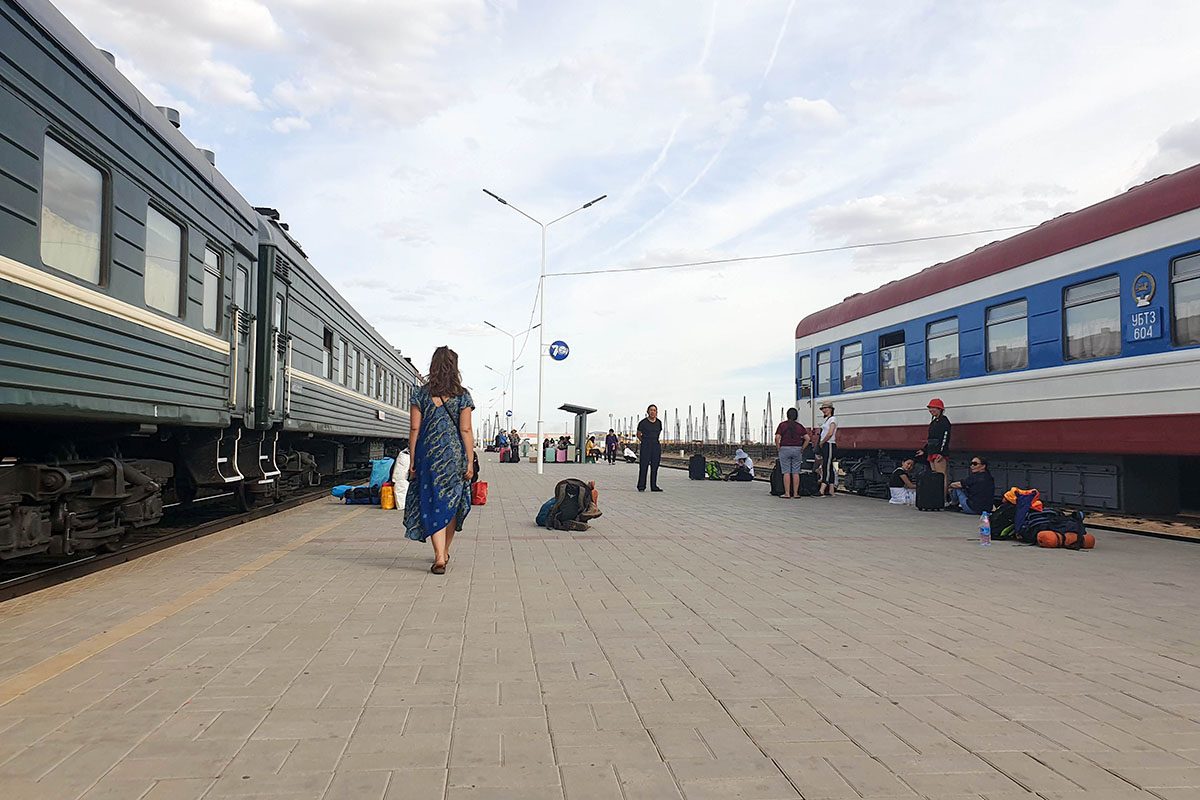Buy your Bus Tickets
Buses now leave from Yongdingmen Station in Beijing to the Mongolian border. The town, located in Inner Mongolia (which is a Chinese province with a large Mongolian population), is called both Erlian and Erenhot. If you go to the station and ask for a ticket to either, you’ll be fine. The #20 bus stops at the bus station (warning: the buses can be VERY confusing), or you can take a taxi for around 25 yuan from Tiananmen Square. Once you’re at the station, you’ll need to go through security and then turn left for the ticket office. Ask for the bus to Erlian/ Erenhot (have the characters written down in Chinese just in case). You can only buy tickets for the bus on the day it leaves. I got there at about 9am and had no problem buying tickets – I’d recommend getting there as early as possible so you can secure them. The bus left at 5:30pm, so I went back to my hostel. You could use the time to see another attraction in Beijing, or just spend the day chilling out before your journey.If you’re looking for a hostel in Beijing, I recommend Leo Hostel, where I’ve stayed both times I’ve visited the capital. It has a bar and restaurant with a great social scene and is a good place to meet other travellers. Click here for rates or to reserve your spot!
Get to the Station and Board the Bus
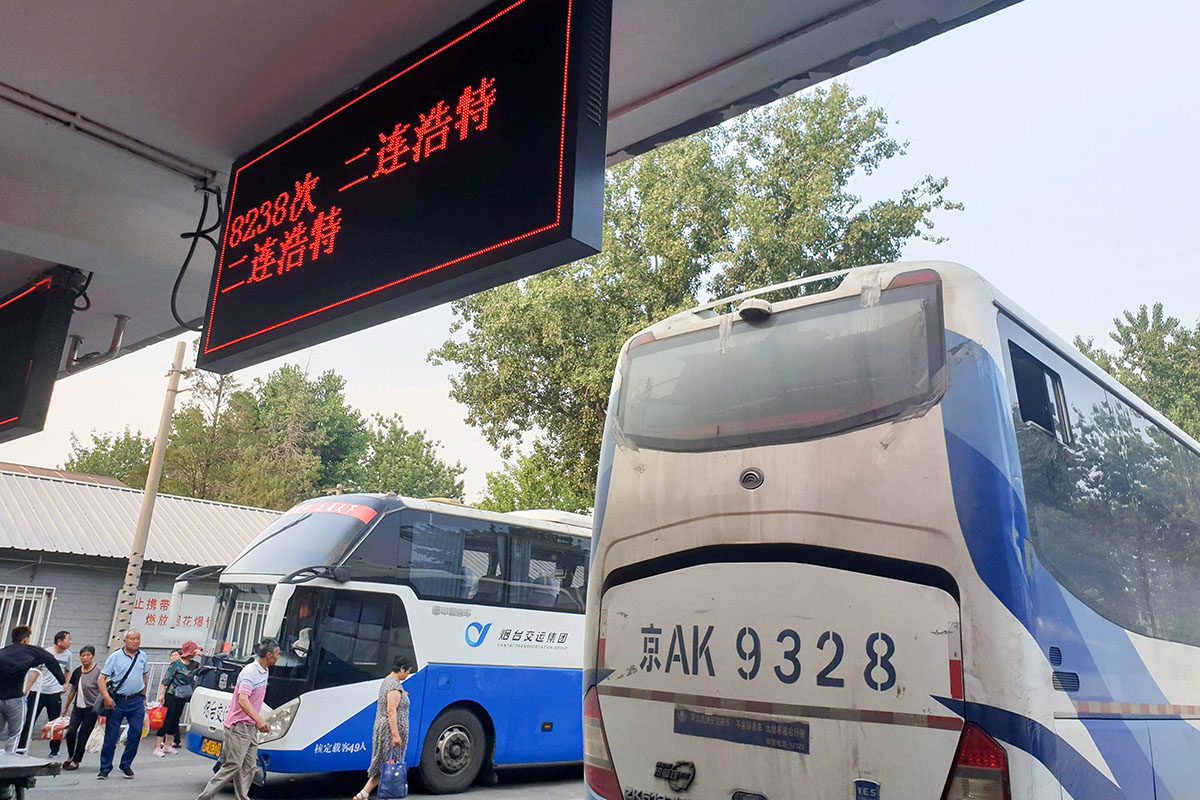 I was advised to get to the station half an hour before departure – I got there at about 4:45pm, but 5pm would have been fine. We didn’t actually start boarding until 5:25pm. Just like getting the train in China, look out for the bus number on the notice board and queue up when it appears over one of the gates.
If in doubt, show anyone and everyone your ticket and do your best ‘lost tourist’ face. It works every time. Many younger people in Beijing speak English, so you might luck out!
We (by we, I mean me and three other guys who thought I could speak Chinese because I knew the word ‘jeger’ and then proceeded to speak to me in Chinese for the next hour – I just nodded and smiled the whole time!) got on the bus at around 5:25pm, were instructed to take our shoes off (like on Vietnamese sleeper buses) and I was pointed to a bed near the front.
I was shocked when the bus left at 5:32pm, as I was told that it was highly unlikely to run on time. But then, of course… we stopped about 10 minutes later where all of the other bus go-ers were, and we had to get off the bus and wait around two hours before we left here.
Other reports have said buses have stopped at shopping malls or other random places… just go with it, put on your patience hat, and wait. You’ll leave when you leave (helpful, I know).
I’m not sure if anyone knows this, but a lot of goods are made in China. Because of this, loads of boxes get put in the bottom of the bus, and it takes a looooong time to load.
Plus nearly all of the passengers are Mongolian; generally, they can’t speak Chinese and the drivers and bus station workers can’t speak Mongolian, so it’s all a bit chaotic.
Unless you’re a Chinese-Mongolian translator, there’s not much you can do apart from sit and observe and maybe make some new pals.
I was advised to get to the station half an hour before departure – I got there at about 4:45pm, but 5pm would have been fine. We didn’t actually start boarding until 5:25pm. Just like getting the train in China, look out for the bus number on the notice board and queue up when it appears over one of the gates.
If in doubt, show anyone and everyone your ticket and do your best ‘lost tourist’ face. It works every time. Many younger people in Beijing speak English, so you might luck out!
We (by we, I mean me and three other guys who thought I could speak Chinese because I knew the word ‘jeger’ and then proceeded to speak to me in Chinese for the next hour – I just nodded and smiled the whole time!) got on the bus at around 5:25pm, were instructed to take our shoes off (like on Vietnamese sleeper buses) and I was pointed to a bed near the front.
I was shocked when the bus left at 5:32pm, as I was told that it was highly unlikely to run on time. But then, of course… we stopped about 10 minutes later where all of the other bus go-ers were, and we had to get off the bus and wait around two hours before we left here.
Other reports have said buses have stopped at shopping malls or other random places… just go with it, put on your patience hat, and wait. You’ll leave when you leave (helpful, I know).
I’m not sure if anyone knows this, but a lot of goods are made in China. Because of this, loads of boxes get put in the bottom of the bus, and it takes a looooong time to load.
Plus nearly all of the passengers are Mongolian; generally, they can’t speak Chinese and the drivers and bus station workers can’t speak Mongolian, so it’s all a bit chaotic.
Unless you’re a Chinese-Mongolian translator, there’s not much you can do apart from sit and observe and maybe make some new pals.
The Bus Journey
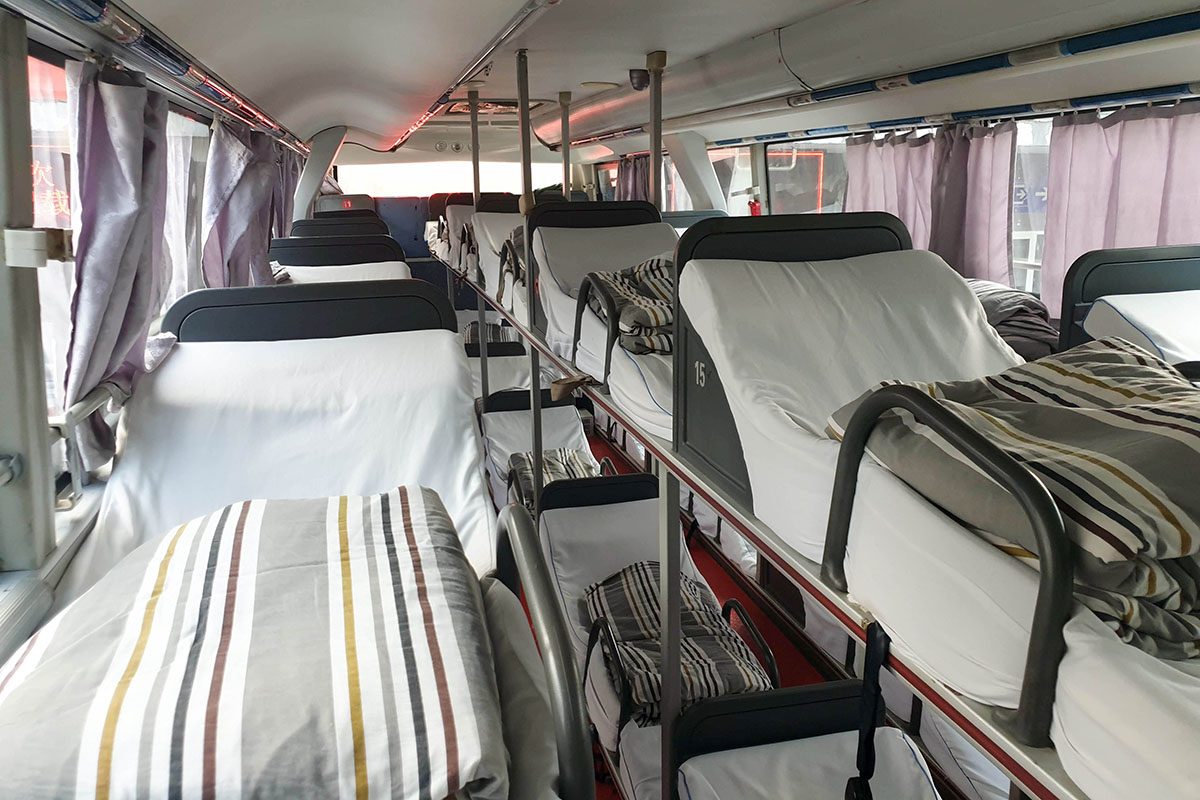 The buses are sleepers which lie down almost flat. They’re pretty comfy – at least for someone of 160cm (me) or less – if you’re taller you might find it a bit of a squeeze. But they’re fine for a night. We ended up leaving at about 8pm.
Once you’re out of the city, the open road is before you, and you’ll drive a considerable distance. We stopped twice, once at around 11pm where people ate dinner (I went for a wee and went straight back to my sleeper!) and then once at about 3am – I think this was for a while, but I couldn’t tell you exactly how long as I was pretty firmly in the land of nod.
I woke up at about 6:30am, and the distance in scenery was striking. We were now in the Gobi Desert, which spans Northern China and Southern Mongolia, stretching out as far as the eye can see. There were also lots of dinosaur figurines – Erlian is famous for its dinos.
The buses are sleepers which lie down almost flat. They’re pretty comfy – at least for someone of 160cm (me) or less – if you’re taller you might find it a bit of a squeeze. But they’re fine for a night. We ended up leaving at about 8pm.
Once you’re out of the city, the open road is before you, and you’ll drive a considerable distance. We stopped twice, once at around 11pm where people ate dinner (I went for a wee and went straight back to my sleeper!) and then once at about 3am – I think this was for a while, but I couldn’t tell you exactly how long as I was pretty firmly in the land of nod.
I woke up at about 6:30am, and the distance in scenery was striking. We were now in the Gobi Desert, which spans Northern China and Southern Mongolia, stretching out as far as the eye can see. There were also lots of dinosaur figurines – Erlian is famous for its dinos.
 After another hour or so, we reached the town centre. Any worries I had about finding someone to help me cross the border (more on that in a sec) immediately disappeared when I got off the bus and was met with about 15 people all offering their jeep services, 14 men and 1 woman.
I decided to go with the women – I’m sure all of the jeep drivers were safe but to me, as a solo female traveler, it makes a little more sense to get in a strange woman’s jeep than a strange men’s jeep.
After another hour or so, we reached the town centre. Any worries I had about finding someone to help me cross the border (more on that in a sec) immediately disappeared when I got off the bus and was met with about 15 people all offering their jeep services, 14 men and 1 woman.
I decided to go with the women – I’m sure all of the jeep drivers were safe but to me, as a solo female traveler, it makes a little more sense to get in a strange woman’s jeep than a strange men’s jeep.
Crossing the border
So the reason for all these jeeps is that you cannot cross the China/ Mongolian border on foot. You need a driver, who will take you in a jeep for a fee. I was quoted 80 CNY when I asked about the fee, but actually ended up paying 100 CNY (I gave my driver a 100 CNY note and never saw the change – although in saying that, so did everyone else in my jeep who was also Mongolian). I think the price could have been haggled, but I have a gold medal in being the world’s worst haggler. Drop me a comment if you do this trip and get it for a cheaper price, I’d love to know how much I was overcharged! I was joined first by a Mongolian man who worked for the UN in Sudan and spoke excellent English. We drove around in the jeep for a while, trying to recruit more border buddies, and eventually were joined by three more people. They were all Mongolian – although again, one of the guys could speak excellent English and was studying in Sydney. It was nice to have these two English-speakers to chat to about Mongolia and to help me across the border, although I would have been ok otherwise!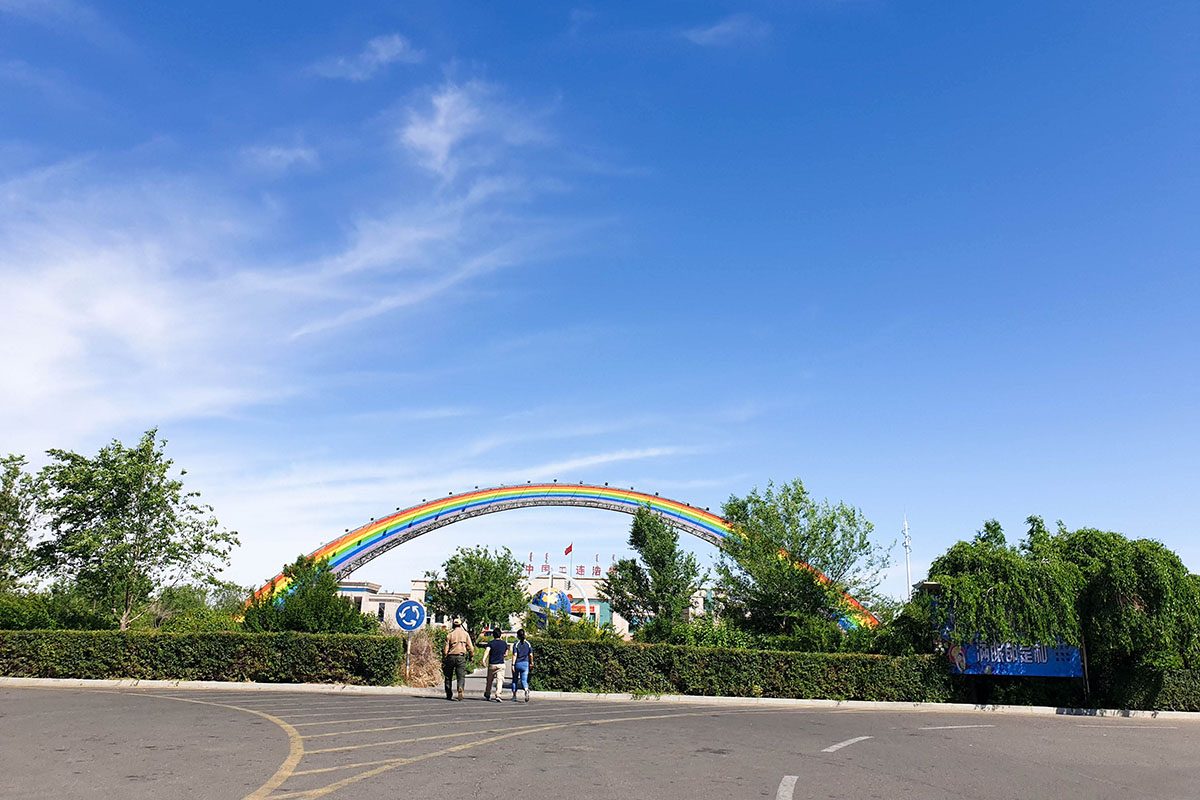 It’s a short way to the border from the town; the border has a large rainbow statue over the immigration office. Leaving China is pretty easy – there’s a form you need to fill in (the jeep driver should have one or they will be at the border) and get your stamp. Then hop back in the jeep and drive the short distance to the Mongolian side.
Mongolia has to have the nicest border staff in the world. I couldn’t understand what my group were talking about, but they were all having a good old laugh with the guard, who genuinely looked like he loved his job. I had my passport and visa checked and was stamped in and welcomed, then I changed my leftover CNY to Mongolian Togrog.
We waited for another 10 minutes or so for the car to cross the border, then we were in Mongolia!
It’s a short way to the border from the town; the border has a large rainbow statue over the immigration office. Leaving China is pretty easy – there’s a form you need to fill in (the jeep driver should have one or they will be at the border) and get your stamp. Then hop back in the jeep and drive the short distance to the Mongolian side.
Mongolia has to have the nicest border staff in the world. I couldn’t understand what my group were talking about, but they were all having a good old laugh with the guard, who genuinely looked like he loved his job. I had my passport and visa checked and was stamped in and welcomed, then I changed my leftover CNY to Mongolian Togrog.
We waited for another 10 minutes or so for the car to cross the border, then we were in Mongolia!
Arriving into Zamiin-Uud
Ask your jeep driver to drop you off by the train station. It’s right near the town square. Then walk towards the station, but before the rails turn left into the modern building and head to the second floor. This is where you’ll buy tickets. There is also WiFi here. All you need to ask for is ‘Ulaanbaatar, today, soft/ hard sleeper (depending on your preference)’. The woman who served me spoke enough English, but if they don’t you can connect to the WiFi and translate. I got a hard sleeper which was a bargain 23,000 togrig (about 6 pound or $9). Soft sleepers are around 35,000 togrog. Once you’ve got your tickets, you’re free to explore the one street of Zamiin-Uud. There’s not that much to do here – there’s a small but pretty well-stocked supermarket, where you can get some noodle soups or the like for dinner, quite a few restaurants and a couple of hotels.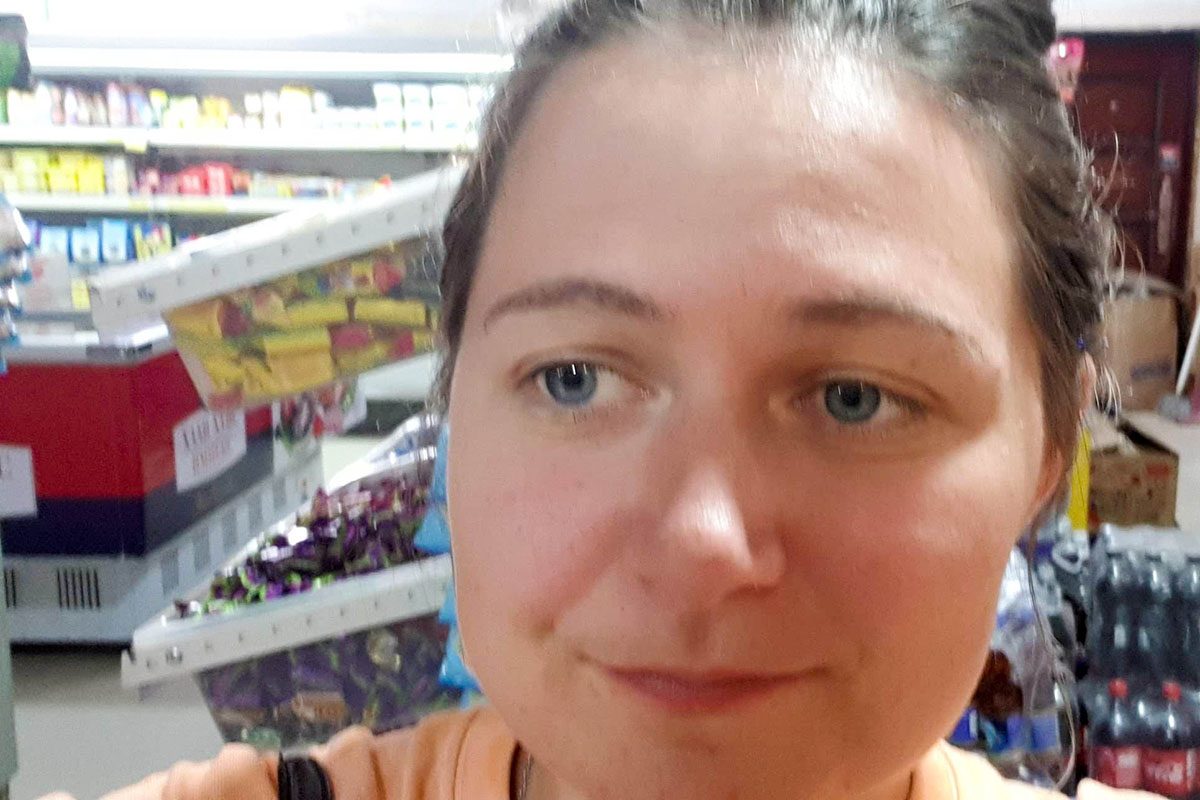
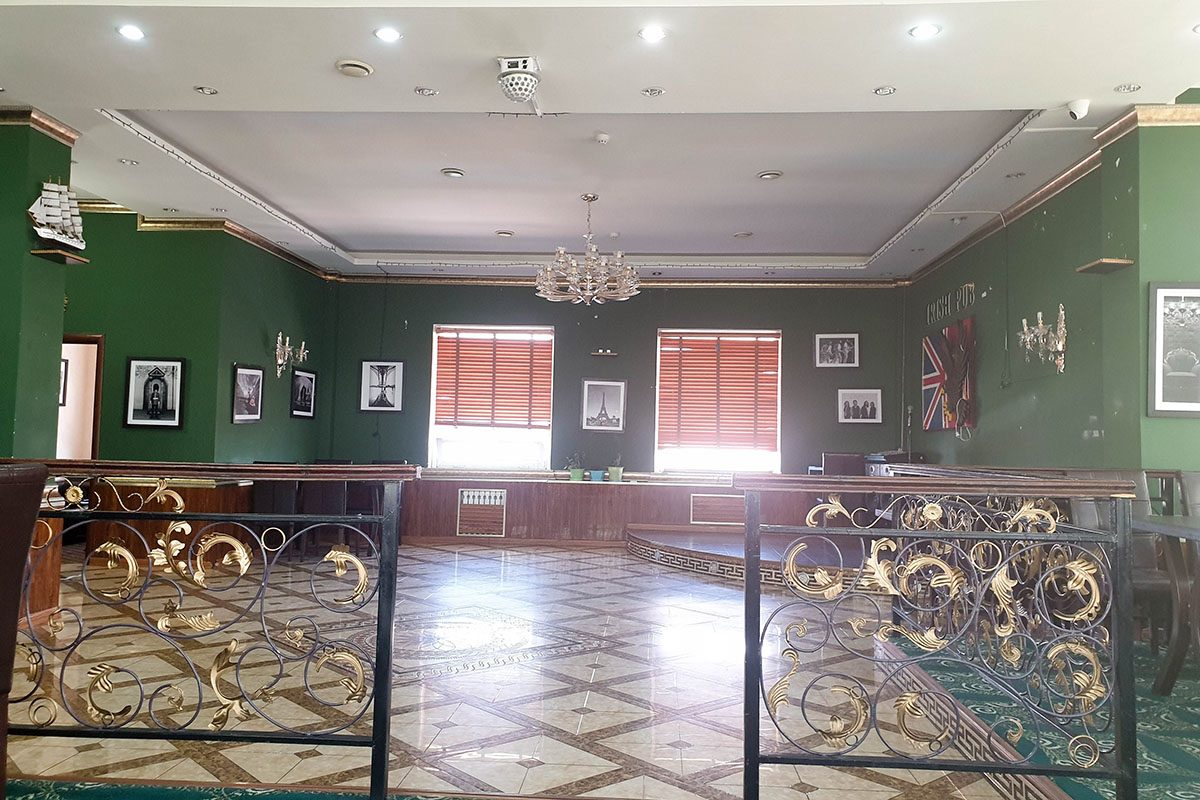 Having exhausted all of the best things to do in Zamiin-Uud after purchasing train tickets, eating and visiting the supermarket, I opted to get a hotel room for the 7 hours wait I had rather than wait at the station. I’m a #flashpacker these days!
I stayed at the ? hotel. If you’re after a shower, make sure you ask on check in – I only had a bath with cold water. I managed to wash by doing a contortion act under the bath tap, but I highly would not recommend this.
Otherwise, it was fine – all I needed were plugs to charge my devices, a kettle for tea and a bed where I could be horizontal for a few hours, and it sufficed. There was also a drinking water dispenser which was much appreciated.
Having exhausted all of the best things to do in Zamiin-Uud after purchasing train tickets, eating and visiting the supermarket, I opted to get a hotel room for the 7 hours wait I had rather than wait at the station. I’m a #flashpacker these days!
I stayed at the ? hotel. If you’re after a shower, make sure you ask on check in – I only had a bath with cold water. I managed to wash by doing a contortion act under the bath tap, but I highly would not recommend this.
Otherwise, it was fine – all I needed were plugs to charge my devices, a kettle for tea and a bed where I could be horizontal for a few hours, and it sufficed. There was also a drinking water dispenser which was much appreciated.
The Train from Zamiin-Uud to Ulaanbaatar
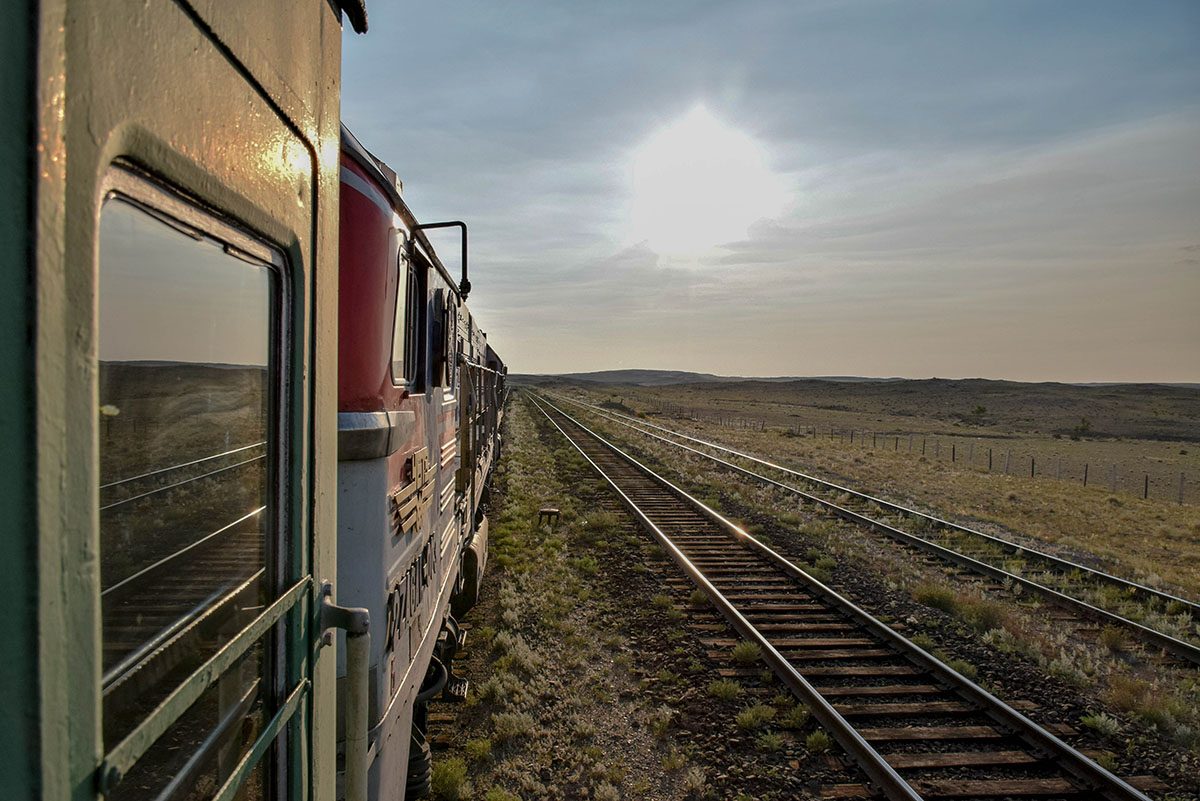 I got to the station at about 5pm; the train was there but boarding hadn’t yet started. I hung around the platform, awkwardly tried to take a photo of myself and ended up making friends with a guy who offered to take my photo (pro tip: awkwardly trying to take photos of yaself is a great way to make travel friends).
We ended up being on the same carriage in neighbouring bunks; weirdly I seem to quite often unknowingly make friends with my train neighbours before we get on the train. Must have a radar for it or something. He was the only other tourist on the train, so it was good to chat and compare notes!
The second-class sleepers are fine, the beds are a little hard but sleepable. Double-check the numbers – the correct seat numbers are on the signs at the end which have two numbers rather than the numbers going horizontally across the seat (I don’t know what they’re about but they caught me out). That should make sense once you’re on the train, if it doesn’t don’t worry – the attendant will soon point you in the right direction.
You can store bags underneath the seat (it opens up, like a chest) or on the upper shelf.
Then, the journey begins. It’s really beautiful, going through the Gobi and stopping off only at some small communities. You’ll get to enjoy the sunset (unless you’re visiting in midwinter, when it will already be dark) and might have the luck of some great train companions.
I got to the station at about 5pm; the train was there but boarding hadn’t yet started. I hung around the platform, awkwardly tried to take a photo of myself and ended up making friends with a guy who offered to take my photo (pro tip: awkwardly trying to take photos of yaself is a great way to make travel friends).
We ended up being on the same carriage in neighbouring bunks; weirdly I seem to quite often unknowingly make friends with my train neighbours before we get on the train. Must have a radar for it or something. He was the only other tourist on the train, so it was good to chat and compare notes!
The second-class sleepers are fine, the beds are a little hard but sleepable. Double-check the numbers – the correct seat numbers are on the signs at the end which have two numbers rather than the numbers going horizontally across the seat (I don’t know what they’re about but they caught me out). That should make sense once you’re on the train, if it doesn’t don’t worry – the attendant will soon point you in the right direction.
You can store bags underneath the seat (it opens up, like a chest) or on the upper shelf.
Then, the journey begins. It’s really beautiful, going through the Gobi and stopping off only at some small communities. You’ll get to enjoy the sunset (unless you’re visiting in midwinter, when it will already be dark) and might have the luck of some great train companions.
 I spent the time chatting with my neighbours – one lady was a Mongolian music teacher who could speak four languages, the other was the friend I’d made on the platform who was from Chengdu in China.
There is hot water available on the train, so bring tea and instant noodles, tuck in and enjoy the ride.
The lights go off at around 10-11pm, although many people were asleep before then.
If you’re up for sunrise, I heard it was beautiful (I was fast asleep) and my cabin-mates even saw some camels!
The train rolls into Ulaanbaatar at around 9-10am.
I spent the time chatting with my neighbours – one lady was a Mongolian music teacher who could speak four languages, the other was the friend I’d made on the platform who was from Chengdu in China.
There is hot water available on the train, so bring tea and instant noodles, tuck in and enjoy the ride.
The lights go off at around 10-11pm, although many people were asleep before then.
If you’re up for sunrise, I heard it was beautiful (I was fast asleep) and my cabin-mates even saw some camels!
The train rolls into Ulaanbaatar at around 9-10am.

Arriving into Ulaanbaatar
You’ll probably be offered some tours and accommodation as soon as you get off the train. However, I highly recommend that you stay and book tours with Danista Nomads Hostel, they’re wonderful people and the hostel/ guesthouse is great. You can very easily hail a cab – there are no uniform cabs but many people work as cab drivers in unmarked cars. Or, the station is close to the city centre and is walkable to most accommodations (including Danista). To Danista the price should be 4,000 togrog, although it’s quite likely that you’ll be quoted higher.Where to Stay in Ulaanbaatar
Hostel: Danista Nomads Hostel is simply wonderful. It’s where I stayed throughout my entire time in Ulaanbaatar, and I really loved it. There are dorms and private rooms; most guests stayed in privates but I was in a dorm. The dorm was wonderfully spacious, with a mezzanine level and table. It had good WiFi, free breakfast which is served in a little yurt, and the loveliest and most helpful staff I’ve ever come across. If you’re looking for a hostel or cheap guesthouse in Ulaanbaatar, stay here. Click here for more information and to book. Mid-Range Hotel: Urgoo Hotel has well-facilitated and rooms with en-suites with rain showers, friendly staff and is in a great location. I didn’t stay here, but was contemplating it before I realised I was skint and needed to stay in a hostel. Click here for more information and to book. Luxury Hotel: The Blue Sky Hotel and Tower – if you want to stay in somewhere iconic in Ulaanbaatar, the Blue Sky Hotel and Tower is perfect. It’s in the city’s most notable building, the ‘sail’ looking skyscraper right in the city centre, and the facilities are top-class. Enjoy a fitness centre, swimming pool, bar and restaurant on site, as well as gorgeous luxury rooms and 5* service. Click here for more information and to book.Things to do in Ulaanbaatar
 Most people visiting Mongolia aren’t spending too much time in the capital – very few, like me, are spending 8 days in the capital trying to get a bladdy Russian transit visa. I was successful, but unfortunately didn’t see all that much of Mongolia outside of the capital. Still, I definitely experienced Ulaanbaatar – read my post all about things to do in Ulaanbaatar for more.
And check out my YouTube video which features all of these places!
Most people visiting Mongolia aren’t spending too much time in the capital – very few, like me, are spending 8 days in the capital trying to get a bladdy Russian transit visa. I was successful, but unfortunately didn’t see all that much of Mongolia outside of the capital. Still, I definitely experienced Ulaanbaatar – read my post all about things to do in Ulaanbaatar for more.
And check out my YouTube video which features all of these places!

